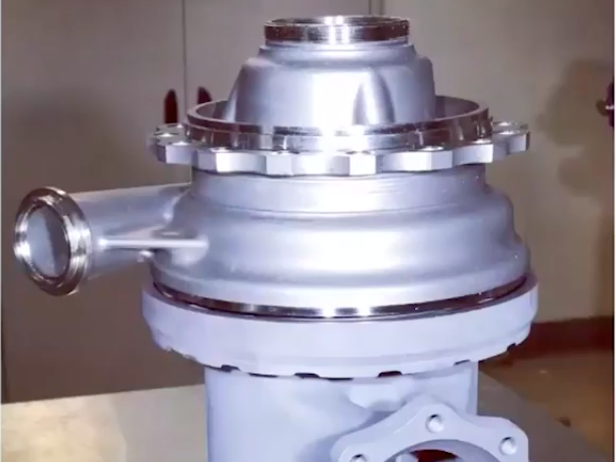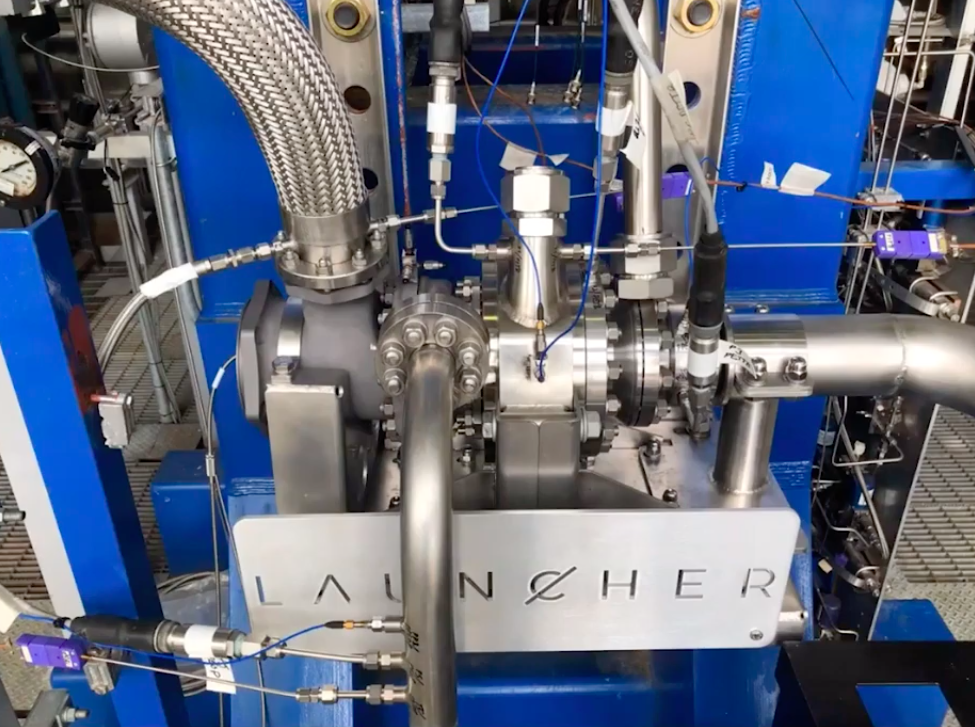Private U.S. Aerospace firm Launcher has collaborated with 3D printer manufacturer VELO3D and simulation software company Ansys to optimize the design of a performance-critical component within its E-2 rocket engine.
Speaking to VELO3D’s Gene Miller during an online webinar, Launcher CEO Max Haot explained how the firms have worked closely to redesign a heritage liquid oxygen (LOX) turbopump. Since being fitted with an upgraded impeller and housings, the revised pump has been tested within Launcher’s engine successfully, and the project has now enabled it to establish a workflow for rapidly iterating future parts.
“As Launcher’s first successful turbopump test, it’s very significant since they are dealing with liquid oxygen in the pump at 30,000 rpm,” explained Haot. “In this type of environment at 4,000 [pounds per square inch] discharge pressure, any anomaly—any rubbing between the rotor and the stator— can result in an immediate rapid unplanned disassembly.”
Reaching maximum thrust
When it comes to small launch vehicles, turbomachinery pumps are often vital to the level of thrust they’re able to achieve, given that they’re directly responsible for injecting propellant into the engine. Prior to its revamp project, Launcher acquired the schematics to such a part from a Ukranian RD-8 rocket to fuel its E-2 unit, an LOX turbo pump that had performed 72 orbital flights onboard the Zenit launcher.
However, to optimize the level of propellant flow and pressure to the engine’s thrust chamber, Launcher needed to produce and test it in-house, thus it turned to VELO3D and Ansys for help. In the project’s initial stages, the firm’s engineers were able to use Ansys’ CFX platform to ensure that the rocket’s projected level of thrust matched its performance, before optimizing its parameters via simulated test runs.
Once the part had been cleared for production, it was 3D printed using a VELO3D Sapphire system, which enabled it to be manufactured with minimal use of supports. Given that the LOX pump’s inlet housing features overhanging internal geometries, VELO3D’s SupportFree technology made creating the part considerably less complex, time-consuming and wasteful than it would otherwise have been.
Using a similar approach, Launcher’s engineers were also able to redevelop the pump’s impeller. Typically, such parts feature a low overhang, making it difficult to incorporate any supports, but using VELO3D’s machine allowed it to be 3D printed flat, providing it with an even mass distribution and preventing it from causing engine issues during rotation.
“By printing the part flat, we got a nice symmetric mass distribution of the part relative to that central rotational axis,” explained Launcher engineer Andre Ivanovic, who was also on the webinar. “Balancing is needed, because if a rotational component in turbomachinery is not balanced, then, on every rotation, there will be a large vibration that’s impulsed into your system and into your bearings.”

A 3D printed pump in practise
Having put together a flight-ready pump prototype, Launcher proceeded to deploy it within extensive engine tests at NASA’s Stennis Space Center. During these performance evaluations, the component proved capable of enduring two-minute test-fires at a nominal rpm, a 30-second input and output pressure check, and a further 30-second 33,000 rpm test.
Following its successful trials, Launcher expects to integrate the newly-optimized E-2 engine into its upcoming ‘Launcher Light’ rocket, which is due to enter service by 2026. Through its collaboration with VELO3D and Ansys, the firm also concluded that it was able to produce a more complex pump at lower costs and lead times than before, demonstrating 3D printing’s utility within rocket building applications.
However, with regards to Launcher’s E-2 turbine, Haot added that it was developed into a flight-ready design, but the final tested part was actually machined. As a result, the firm now intends to iterate the turbine further, by fitting it with an Inconel housing that should provide it with a flow path similar to that identified during its earlier evaluations.
“This turbine is traditionally machined, and in its current state it’s not flight-weight,” concluded Haot. “The next step in the development of the turbine after the successful tests we had, is developing a VELO3D Inconel housing to integrate the flow path that we tested (at Stennis Space Center).”

Launcher’s AM-optimized engines
Since it was founded in 2017, Launcher has continually used 3D printing to upgrade the performance of its rocket engines, and the the firm’s new turbopump is actually set to be fitted inside an entirely additive manufactured combustion chamber, which itself was produced in a single piece using an M 4K AM 3D printer provided by EOS subsidiary AMCM.
Development of the E-2 engine’s 3D printed components dates back to a $1.5 million Space Force contract, which Launcher was awarded back in November 2019. At the time, the firm produced a rocket combustion chamber that was reportedly the largest part of its kind, measuring 860 mm tall and featuring a 410mm exit nozzle.
Similarly, during 2019, SLM Solutions was contracted to develop a 3D printed rocket engine for British spaceflight company Orbex, which was tipped as being the largest of its kind in the world. Built to power Orbex’s Prime launch vehicle, the part was printed as a single piece in order to eradicate the use of any joints, and strengthen its overall integrity.
To stay up to date with the latest 3D printing news, don’t forget to subscribe to the 3D Printing Industry newsletter or follow us on Twitter or liking our page on Facebook.
For a deeper-dive into additive manufacturing, you can now subscribe to our Youtube channel, featuring discussion, de-briefs and shots of 3D printing in-action.
Are you looking for a job in the additive manufacturing industry? Visit 3D Printing Jobs for a selection of roles in the industry.
Featured image shows Launcher’s 3D printed turbo pump assembly. Photo via Launcher.


